Successful navigation through AP Inter 1st Year Botany Model Papers and AP Inter 1st Year Botany Question Paper May 2015 builds students’ confidence in their exam-taking abilities.
AP Inter 1st Year Botany Question Paper May 2015
Time: 3 Hours
Maximum Marks: 60
General Instructions:
Note : Read the following instructions carefully.
- Answer all questions of Section ‘A’. Answer any six questions out of eight questions in Section ‘B’ and answer any two questions out of three in Section – ‘C’.
- In Section ‘A’, questions from Sr. Nos. 1 to 10 are of “Very Short Answer Type”. Each question carries two marks. Every answer may be limited to five lines. Answer all the questions at one place in the same order.
- In Section ‘B’, questions from Sr. Nos. 11 to 18 are of “Short Answer Type”. Each question carries four marks. Every answer may be limited to 20 lines.
- In Section – C, questions from Sr. Nos. 19 to 21 are of “Long Answer Type”. Each question carries eight marks. Every answer may be limited to 60 lines.
- Draw labelled diagrams wherever necessary for questions in Sections ‘B’ and C.
Section – A (10 × 2 = 20)
Note : Answer all questions. Each answer may be limited to 5 lines.
Question 1.
What is flora ?
Answer:
Actual account of Habitat, distribution and systematic listing of plants of a given area is called flora.
Question 2.
What do the terms phycobiont and mycobiont signify ?
Answer:
The algal component in a Lichen is called Phycobiont.
The fungal component in a Lichen is called Mycobiont.
Question 3.
What is palaeobotany ? What is its use ?
Answer:
Study of fossil plants is called palaeobotany. It helps in understanding the course of evolution in plants.
Question 4.
What is the morphology of cup like structure in cyathium ? Irr which family it is found ?
Answer:
In cyathium, cup like structure is formed from “Involucre of Bracts”. It is seen in “Euphorbiaceae” family.
![]()
Question 5.
Which type of fruit is found in mango ? How does it differ from that of coconut ?
Answer:
In mango, the type of fruit is Drupe.
In coconut, the fruit is Drupe, but epicarp and mesocarp are fibrous. Endocarp is stony with edible endosperm.
Question 6.
What is omega taxonomy ?
Answer:
Taxonomy based on information from other branches ie., embryology, cytology, palynology, phytochemistry, serology etc along with morphological characters is called omega taxonomy.
Question 7.
What is middle lamella made of ? What is its functional significance ?
Answer:
Middle lamella is made of calcium pectate and magnesium pectate. It holds or glues the neighbouring cells.
Question 8.
Give two examples for each amino acids and nucleotides.
Answer:
Amino acids : Glycine, Alanine
Nucleotides : Adenylic acid, Guanylic acid.
Question 9.
An anther has 3600 pollen grains. How many pollen mother cells must have been there to produce them ?
Answer:
\(\frac{3600}{4}\) = 900
Question 10.
Define communities. Who classified plant communities into hydrophytes and xerophytes ?
Answer:
An assemblage of all populations belonging to different species occurring in an area is called community. Warming classified plant communities into hydrophytes & xerophytes.
![]()
Section – B (6 × 4 = 24)
Note : Answer any six questions. Each answer may be limited to 20 lines.
Question 11.
Explain binomial nomenclature.
Answer:
Naming the plants with two words is called Binomial nomen – clature. It was first inroduced by Gaspard Bauhin (1623) but the credit goes to Linnaeus (1753).
In Binomial nomenclature, each and every plant has a name with two words, they should be in Latin. The first word in Genus and the second word is Species. The generic name will be in noun form and always starts with capital letter. The specific name will be in adjective form and starts with small letter. The Botanical name should be printed in Italics and should be underlined. For ex : Solanum tuberosum – Potato plant in which Solanum is the generic name and tuberosum is the species name.
Question 12.
Differentiate between red algae and brown algae.
Answer:
| Red algae | Brown algae |
| 1. They belongs to the class Rhodbphyceae. | 1. They belongs to the class Phaeophyceae. |
| 2. Most of them are marine and some are fresh water forms. | 2. They live in fresh water, brackish and salt water. |
| 3. The Thallus is multicellular. | 3. The Thallus range from simple branched filamentous form to profusely branched forms. |
| 4. The major pigments are chlorophyll a, d and r- phyco erythrin. | 4. The major pigments are chlorophyll a, c, carotexnoids and xanthophylls (fucoxanthin). |
| 5. Flagella are absent. | 5. Flagella are 2, unequal lateral. |
| 6. Cellwall is made up of cellu-lose, pectin and poly sulphate esters. | 6. Cellwall is made up of cellulose and algin. |
| 7. Food materials are stored in the form of floridean starch. | 7. Food materials are stored in the form of mannitol and laminarin. |
| 8. Asexual reproduction is by non – motile spores. | 8. Asexual reproduction is by Biflagellate zoospores. |
| 9. Sexual reproduction occurs by non – motile gametes. Ex : Polysiphonia, Porphyra | 9. Sexual reproduction occurs by motile gametes. Ex : Ectocarpus, Laminaria, Sargassum. |
Question 13.
Write a brief account on gametogenesis with examples.
Answer:
The process of formation of male and female gametes is called gameto genesis. In some algae, the two gametes are similar in appearance. They are called Homogametes (Isogametes). Ex: Cladophora. In majority of sexually reproducing organisms, the two gametes formed are morphologically different. They are called Heterogametes. The male gamete is called antherozoid and the female gamete is called the egg. Ex : Funaria, pteris.
Question 14.
Describe the essential organs of Solanaceae.
Answer:
Androecium and Gynoecium are essential organs.
Androecium : 5 stamens, epipetalous, alternate to petals. The anthers are large, dithecous, basifixed, Introse and dehiscence. Longi – tudinally (Datura) or porous (Solanum).
Gynoecium : Bicarpellary, syncarpous, superior ovary with numerous ovules arranged on swollen axile placentation. Ovary is oblique in position due to tilting of posterior carpel to the right and anterior carpel to the left at an angle of 45°. The style is terminal and the stigma is capitate.
Question 15.
Describe the structure and function of power house of the cell. Draw labelled diagram.
Answer:
Mitochondria is termed as power houses of the cell. It is 0.2 to 1.0 µm in diameter, 1.0 to 4.1 µm in length, appears in cylindrical shape.
Each Mitochondria is a double membrane bound structure with outer smooth membrane and inner membrane with infoldings towards inside called cristae. The space inner to inner membrane is called matrix, which consists of single, circular DNA, few RNA molecules, 70s type of ribosomes and the components required for the synthesis of proteins. The cristae shows several stalked particles called F1 particles or oxysomes.
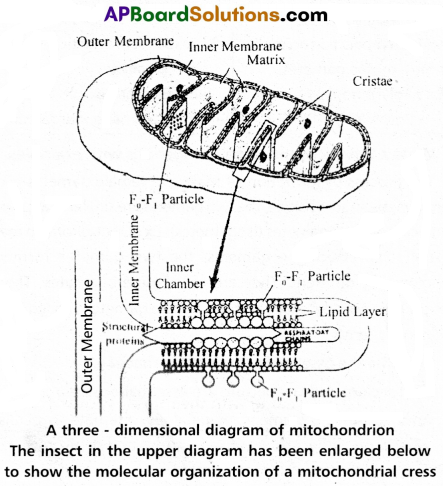
Function : Food materials undergo oxidation and releases energy in the form of ATP so called power houses of the cell.
![]()
Question 16.
Though redundantly described as a resting phase, interphase does not really involve rest. Comment.
Answer:
The Interphase, also called phase of non apparent division though called the resting phase is the time during which the cell is preparing for division by undergoing both ceil growth and DNA replication. The Interphase is divided into three phases.
They are
A) G1 phase : It is the interval between mitosis and Initiation of DNA replication. In this cell is metabolically active and continuously grows.
B) ‘S’ phase : In this, DNA replication occurs. The amount of DNA per cell doubles. However three is no increase in the number of chromosomes.
C) G2 phase : Proteins are synthesized in preparation for mitosis while cell growth continues.
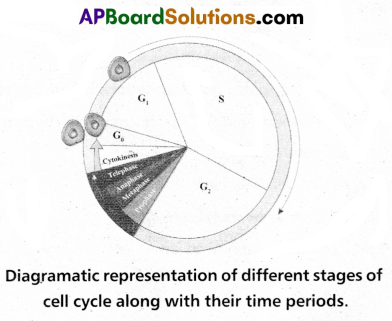
Question 17.
State the location and function of different types of meristems.
Answer:
Based on the position, meristems are classified into 3 types. They are
- Apical meristems : The meristems that are present at the tip of the root and at the tip of the stem are called apical meristems. They help in leniar growth of the plant body.
- Intercalary meristems : The meristems that are present between mature tissues are called intercalary meristems. They help in the internodal elongation of the plant.
- Lateral meristems : The meristems that occur in the lateral regions of roots and shoots called lateral meristems. They help in increase in thickness of the plant organs. Ex : Vascular cambium.
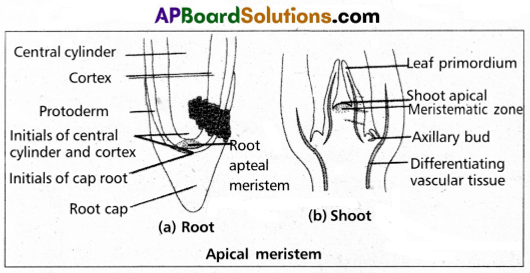
Question 18.
Give in detail the anatomical adaptations shown by xerophytes.
Answer:
- Epidermis is covered with thick cuticle to check the rate of transpiration.
- Epidermal cells may have silica crystals.
- Epidermis may be multilayered.
- Stomata are confined to lower epidermis of leaves called Hypostomatous. They are present in pits called sunken stomata.
- Mechanical tissues are very well developed.
- Vascular tissues are very well developed.
Section – C (2 × 8 = 16)
Note : Answer any two questions. Each answer may be limited to 60 lines.
Question 19.
Define root modification. Describe root modifications with example. Draw labelled diagrams.
Answer:
Root Modifications :
In some plants, roots change their shape and structure to perform functions other than absorption and conduction of water and Minerals called root modifications. They are of different types.
- In Carrot, turnip (Tap roots), Sweet potato (Adventitious roots), Asparagus (Fibrous roots) become swollen due to storage of food called storage roots.
- In Banyan tree, Roots arise from the branches grow into the soil, become pillar like and give additional support called prop roots or pillar roots.
- In Maize, sugarcane, roots arise from the lower nodes of the stem, give additional support called stilt roots.
- In Mangroves like Rhizophora and Avicennia, Many roots come out of the ground and grow vertically upwards, help in respiration called Pneumatophores.
- In Epiphytes like Vanda, special adventitious roots arise, help in absorption of moisture from atmosphere called Velamen roots.
- In partial parasites like viscum and striga, some haustorial roots enter into xylem of the host plant to get water and minerals. In complete parasitic like Cuscuta and Rafflesia, the haustorial roots enter into xylem and phloem of the host plant and obtain water and minerals and food materials called Parasitic roots.
- In the members of Fabaceae, the roots are inhabited by Rhizobium bacteria which helps in N2 fixation called Nodular roots.
- In some plants like Taeniophyllum, the roots are chlorophyllous and perform photosynthesis so called photosynthetic roots.
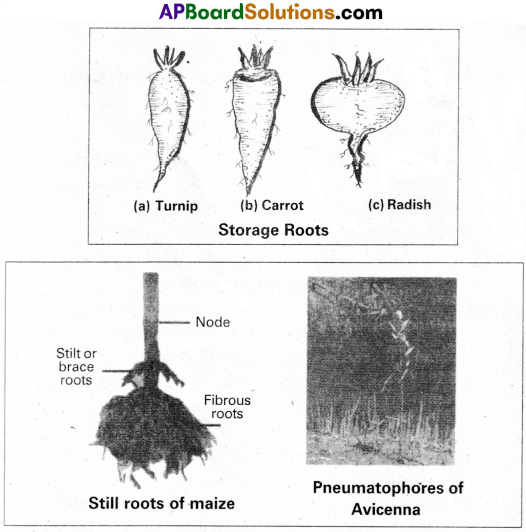
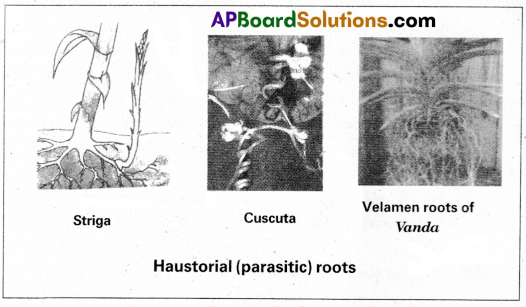

![]()
Question 20.
Describe the process of fertilization in angiosperms with the help of neat labelled diagrams.
Answer:
The fusion of male and female gametes is called fertilization. The process of fertilization in angiosperms is described under the following five steps.
A) Entry of the pollen tube into the ovule : The pollen tube enters into the ovule in 3 ways.
- Pologamy : Pollen tube enters into the ovule through microphyle.
e.g. : Ottelia, Hibiscus. - Chalazogamy : Pollen tube enters into the ovule through chalaza.
e.g. : Casiarina. - Mesogamy: Pollen tube enters into the ovule through integu¬ments or funiculus.
e.g. : Cucurbita.
B) Entry of pollen tube into the embryo sac : The pollen tube enters into the embryo sac only through the microphylar region either by destroying one of the synergids or in between egg cell and synergid. The entry of pollen tube is directed by filiform apparatus.
C) Dicharge of male gametes or sperms : After entry of pollen tube into the embryosac, the male gametes are liberated by one of the following ways.
a) Tip of the pollen tube may burst out.
b) Degeneration of the tip of the pollen tube.
c) Formation of an apical pore at the tip of the pollen tube.
The pollen tube finally releases the intact male gametes and vegetative nucleus.
D) Gametic Fusion : One of sperm nucleus [first sperm] fuses with egg cell and forms a dipliod zygote (2n). This fusion is called syngamy or fertilization. It was first discovered by Strasburger (1884).
E) Triple fusion and Double fertilization : The second sperm nucleus fuses with the secondary nucleus of the embryosac and forms Primary endosperm nucleus [PEN]. This fusion is called as Triple fusion. It was first observed by Nawaschin in Lilium and Fertillari’a. In angiosperms the two male gametes release into the embryo sac take part in two fertilizations. The first sperm nucleus combines with egg cell to form zygote and the second sperm nucleus combines with secondary nucleus to form primary endosperm nucleus. With the occurrence of two fertilizations, this phenomenon is, i.e., Double (fertilization) includes syngamy as well as triple fusion. It results in the formation of fertile endospermic seeds.

![]()
Question 21.
Describe the T.S. of Dicot stem. Draw neat labelled diagram (sector only).
Answer:
The structure of young dicot stem can be clearly understood by observing the transverse section of stem of Helianthus annus (sunflower). It shows three major zones, namely epidermis, cortex and stele.
1. Epidermis : It is the outer most layer of rectangular or tubular cells arranged compactly without any intercellular spaces. On outer surface of epidermis, a waxy layer called Cuticle is found. The cuticle is chemically composed of a substance cutin. The cell walls of epidermis also show the presence of cutin. Stomata are present in the epidermis. Multicellular trichomes develop on the epidermis. The cuticle and the trichomes check the evaporation of water and protect the stem from high temperature.
The epidermal layer gives protection to the inner tissues and also prevents the evaporation of water from the plant body. Through stomata, the epidermis allows the exchange of gases and promotes transpiration. Trichomes prevent entry of pathogens.
2. Cortex : The part extending between the epidermis and the stele is known as cortex. The cortex is smaller than the stele. It shows three sub-zones, namely,
i) Hypodermis
ii) General Cortex and
iii) Endodermis.
i) Hypodermis : This is the outermost part of cortex and composed of 3 – 6 rows of collenchy- matous cells. It is found beneath the epidermis and helps in providing tensile strength (elasticity) to the stem. The ceils are arranged compactly without intercellular spaces and show excessively thickened corners. The cells are filled with active vacuolated cytoplasm possessing chloroplasts. Thus, the hypodermis also helps in the assimilation of food materials. It also gives mechanical strength.
ii) General Cortex : It is found beneath the hypodermal layer and is made up of 5 – 10 rows of thin walled, living parenchyma cells with or without intercellular spaces. These cells may be isodiametric or oval or spherical. The outer layers of cells contain chloroplasts and in the inner layers leucoplasts are found. The general cortex is primarily concerned with the assimilation and storage of food materials.
iii) Endodermis : The inner most layer of cortex is called endodermis. The cells are barrel shaped, compactly arranged without intercellular spaces. The endodermis cells contain vacuolated proto plasts and show starch grains. So it is also known as ‘Starch Sheath’.
3) Stele : The central conducting cylinder is called the ‘Stele’. It occupies a major part of the stem. It is composed of 4 parts.
i) Pericycle
ii) Vascular bundles
iii) Pith or Medulla and
iv) Medullary rays.
i) Pericycle : It is present in the form of a discontinuous ring and is made up of 3 – 5 rows of the thick walled, dead, lignified cells which gives mechanical strength to the stele. It appears as semilunar patches of sclerenchyma above the vascular bundles with intervening masses of parenchyma.
ii) Vascular bundles : About 15 – 20 vascular bundles are , arranged in the form of a ring. This arrangement is called eustele. Each vascular bundle is wedge or top shaped. In the vascular bundels xylem and phloem are arranged on the same radius. A meristematic layer of cells called cambium is present in between the xylem and phloem. So they are called conjoint, collateral, open vascular bundles. Xylem is at the lower side and phloem at the upper side of the vascular bundle.
Xylem consists of vessels and xylem parenchyma. There may be few tracheids and xylem fibres. The metaxylem is towards the pericycle and protoxylem towards the pith. This is called endarch xylem. Phloem consists of sieve tubes companion cells and phloem parenchyma. Xylem and phloem are vascular tissues which conduct water, mineral salts and organic solutes respectively.
iii) Medulla : It is the central part of the stele and filled with thin walled parenchymatous cells, showing intercellular spaces. It is well – developed, extensive and occupies a large part of the stele. The chief function of the medulla is to store food materials.
iv) Medullary rays : The cells of the medulla extend to the periphery in between the vascular bundles. These cells are horizontal rows of thin walled, living and elongate radially, forming primary medullary rays.
The medullary rays connect the stele with the cortex and are helpful in lateral conduction.
